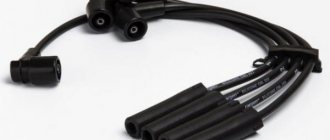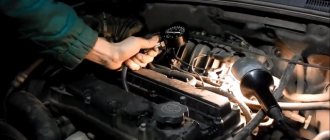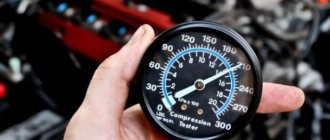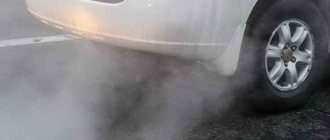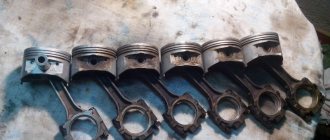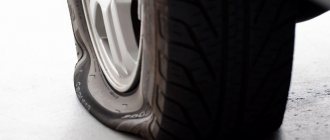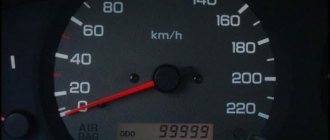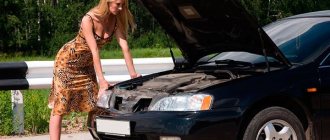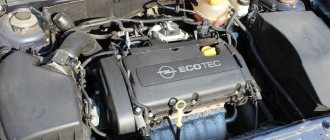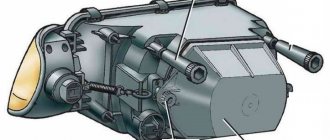string(10) “error stat”
Popping sounds in the muffler is a problem that deserves the attention of a car enthusiast: most often this indicates an engine malfunction. Most often, such excesses occur in power units in which fuel is supplied through a carburetor, although there is a chance to hear them from cars running on gas.
Carburetor power units differ from their more modern counterparts in their frequent overflow, but this is far from the only cause of problems. Popping noises in the muffler at idle speed are a consequence of the fact that the mixture of air and fuel does not burn and enters the intake manifold. It is there that its explosion occurs, which gives rise to a loud, specific sound.
The situation when the engine shoots into the muffler is typical for engines that run on any type of fuel. Yes, it is carburetor power units that hold the palm and “please” with pops most often, but owners of cars with injectors are not immune from this problem.
So why does it shoot at the muffler? Contrary to popular belief, the reason for the spontaneous ignition of the mixture is not only a violation of the gas distribution phases - in fact, there are many more reasons for such a problem. Therefore, with a high degree of probability, the usual replacement of the engine air filter and debugging of the fuel supply may not be enough.
Air filter problems
An incorrect ratio of air and fuel in the fuel mixture is the most likely answer to the question “why does the muffler shoot?” If your car has a carburetor, air will have to pass through the air filter to get into the engine. When it becomes clogged, the volume of air intake per unit of time drops, which disrupts the composition of the mixture and the operation of the power unit as a whole.
Problems with the air filter lead to incomplete combustion of fuel and its residues entering the manifold and exhaust system. There, due to high temperature and pressure, spontaneous combustion and popping occurs. At the same time, when over-gasping, loud pops in the muffler occur more often, since the air-to-fuel ratio will be minimal, and the entry of unburnt mixture into the manifold will be maximum.
Faulty ignition system
Another reason that the fuel does not burn completely and popping sounds from the exhaust pipe can be heard is that the ignition is not set correctly. In particular, if the ignition is late , then popping noises in the muffler at idle and at high speeds are inevitable. This fact is very simple to explain. A situation occurs when a spark appears at the moment when the supply valve has already fully opened, as a result of which part of the fuel does not have time to burn, but leaks into the manifold. And if the ignition is “early” , then it will “shoot” at the air filter.
Checking the spark plugs
Also, the cause of incomplete combustion of fuel can be a weak spark. In turn, this is a consequence of one of the facts:
- Poor contacts on high-voltage wires. It is necessary to inspect them and clean them if necessary. You should also check that there is no ground fault.
- Malfunctions in the operation of the distributor . It is also advisable to check its operation.
- Partially failed spark plugs . If at least one of them has exhausted its service life, this affects the power of the spark it produces. Because of this, not all fuel is burned. Check and replace spark plugs if necessary.
Incorrect carburetor setting
An incorrectly configured carburetor is the second most common cause of unfortunate popping noises in the muffler. It is this unit that is assigned an important function: to form a mixture of air and fuel with the correct ratio of components. If the oxygen content is too low, exactly the same situation occurs as in cases of a clogged air filter.
The sequence of actions is simple:
- Checking the fuel level in the chamber with a float. It should not differ from the maximum permissible for your car model. When removing the cover, the float should be almost level with it.
- If the level is not normal, adjust it.
- Simultaneously with the adjustment, it is worth checking for damage to the float itself - this is often misleading when adjusting the carburetor.
- If the tips listed above did not help and the popping continues, it is worth checking the jets. There are only two options here: they may become clogged or be incorrectly configured. In both cases, the saturation of the mixture with air will be insufficient.
Important: the main symptom of a problem with the carburetor is popping noises in the muffler when releasing gas or when the speed increases sharply.
UAZ 469 shoots into the muffler
The UAZ was driving without any problems and suddenly troubles started - it barely drives (can’t accelerate more than 60 km/h) and shoots into the air. filter and carburetor.
I looked for the problem in these places:
1. installed a new distributor 2. changed the high-voltage wires 3. changed the spark plugs 4. cleaned the carburetor 5. changed the carburetor 6. the fuel pump pumps normally through the fine filter into the carburetor. 7. I filled in different gasoline (instead of 92 I filled in 95), but... It comes from the same gas station and other cars drive it without problems.
For some reason, the insulator on one spark plug is white and the other three are black.
LEFT TO CHECK THE CLEARANCE IN THE VALVES, THEY CLICK BUT NOT MUCH and we don’t know where to dig next.
I know that when setting the valves on the first cylinder, there should be gaps on both, but I can’t determine this until the cover is removed, and also if I’m not confusing anything, then in one book it was written that high-voltage wires are placed on cylinders 1-2-4-3 and the first cylinder is considered from the driver (cabin) and in another book, when installing the distributor, the slider should be directed between the 1st-2nd cylinder (counting from the engine cooling radiator), in general I am confused where the 1st cylinder is from the radiator or from the cabin. There are no books at hand.
The distributor is now standing as it was when the car was driving normally, I did not remove the cast iron leg of the distributor, which means the distributor itself cannot be installed any other way.
Source
Thermal gap
Experienced car enthusiasts and experienced craftsmen first recommend carefully studying the problem. The first step will be to test the engine at different speeds and identify the relationship between the number of revolutions and the appearance of the unfortunate pops. If there are more of them when you press or release the gas pedal, problems with the thermal clearance of the valves on the cylinder block are first suspected. Another pattern that invariably points to this problem is an increase in the frequency of popping noises as the engine temperature increases. In fact, even with stable operation at the same speed, sharp sounds will occur more and more often.
Quite often, camshaft tappets are installed a short distance from the valve itself. If the valves are not tightly connected to the seat, the running engine will heat up, the metal will expand and the mixture will begin to enter the intake manifold. The problem can be solved very simply: you just need to adjust the position of the valves on the cylinder block.
UAZ 3303 2 doors. onboard, 76 hp, 4 manual transmission, 1985 – 1997. - shots in a silencer
contents .. 111 112 113 ..Shots in the engine muffler
| Adjust the clearances in the valve drive | ||
| Exhaust valves sticking in their bushings: increased valve stem or bushing wear, sediment or broken valve springs | Inspection during engine disassembly | Have the engine repaired at a service station |
| Disturbed valve timing | Check valve timing | Establish the correct relative position of the shafts. Check compression |
| Spark plugs are faulty: current leakage through cracks in the insulator or carbon deposits on the heat cone, poor contact of the central electrode | Spark plugs are checked at a special stand (STO). The absence of external damage and sparking between the electrodes on the inverted spark plug does not allow us to draw a conclusion about its functionality | Replace spark plugs |
| Damage to the insulation of high-voltage devices and circuits - interruptions in sparking | Using an ohmmeter, check for open or breakdown (short to ground) of the ignition coil windings and high-voltage wires | Replace the faulty ignition coil, damaged high-voltage wires (when disconnecting the wire, pull its tip). In severe operating conditions, it is advisable to replace the wires every 3–5 years |
| Faulty injectors | Check the operation of the injectors | Replace faulty injectors |
Causes of shots in a silencer
The reason that the engine shoots into the muffler is usually one - the combustible mixture, which did not have time to burn during the working cycle, explodes inside the intake mechanism as a result of heating to high temperatures. This causes a loud bang.
A similar breakdown can occur on any engine, regardless of the fuel on which they operate and its other parameters. Therefore, both injection and carburetor power plants sometimes shoot.
The cause of such problems is not only a mismatch of valve timing, as many people think.
When the engine starts shooting at the muffler, you immediately need to check the carburetor and air filter. Most often, to eliminate this drawback, it is enough to replace the air filter and adjust the fuel supply to the carburetor. But the reason for the popping may lie elsewhere.
Thermal clearance problems
Usually, when popping noises occur, car owners begin to check the operation of the engine under various load levels. If problems occur at high and low speeds, this most likely indicates a malfunction in the size of the valve thermal clearance on the cylinder block. In this case, popping noises will also often occur as a result of overheating of the power unit.
The camshaft tappets should always have a small amount of play where they contact the valve. When the engine warms up, the metal of the parts expands slightly, and the thermal gap will decrease. Properly positioned valves should fit snugly to the seat.
In the absence of this gap, the valve will not be able to tightly close the gap; during the compression stroke, the fuel mixture will pass into the exhaust manifold, in which it will ignite, resulting in sharp pops.
If the cause of the malfunction lies in the thermal gap, the usual adjustment of the valve position will help.
Ignition retard
Ignition problems sometimes also lead to the engine firing into the muffler. When such a malfunction occurs, you should immediately check whether the ignition timing is set correctly. If it is delayed, there is no way to avoid shots. In this case, the spark that ignites the fuel will be supplied late - when the intake valve opens. In this case, a small volume of fuel will be released into the collector. It is worth noting that not only the exhaust pipe can burn out, but also the valve. But this will only happen if you ignore the claps for a long time.
If the ignition is set normally, but shots still occur, the problem lies in a weak spark. In addition, this is caused by faults in the wire contacts, contact group and toggle switch. A weak spark can also occur due to problems with the spark plugs, so you need to make sure that they are in working order. A common problem is the mismatch of its heat rating for a given engine.
Timing phase violation
If the engine starts firing at the muffler, this may be the result of a failure of the gas distribution phases. The same situation will arise in the combustion chamber as with an ignition delay: the intake valve will open before the combustion of the fuel. The remaining gasoline will burn out inside the exhaust pipe, which will cause shots.
This can also be caused by stretching the timing belt. The phases themselves do not go astray; if the mechanism uses a belt drive, then most likely the reason is the belt stretching. Does the muffler pop only when the engine is warm, but not when the engine is cold? The problem definitely lies in the timing belt.
Popping sounds in the injector
On injection engines, this problem is quite rare. When they appear, the cause is a phase failure, ignition fault or thermal gap, as in the case of carburetors. In addition to the above, such a breakdown may be the result of insufficiently reliable sensor contacts. In this case, incorrect data will be supplied to the control device, and the electronic control unit will manage the combustible mixture in accordance with such signals. In this case, only a thorough diagnosis of the car can identify the problem.
Of course, you can use the car when the engine fires, but this will lead to serious engine damage. Therefore, when such a malfunction occurs, it is best to immediately go to a service station.
The article is, of course, more of an overview - but it reflects all aspects of this problem; from experience I will say that often on injectors it is the belt that has stretched or jumped on a tooth.
Poor quality gasoline
Another reason is poor quality gasoline or low octane number
Specifications
Technical characteristics of UAZ 3303 in a body of 2 doors. onboard with a 76 hp engine, 4 manual transmission, produced from 1985 to 1997.
Basic data
- Start of production:
January 1985 - End of production:
January 1997
- Body:
2 doors onboard
Engine
- Fuel grade: gasoline 76
- Engine capacity, cubic meters see: 2445
- Valves per cylinder: 2
- Power, hp: 76
- Achieved at vol. per minute: 4000
- Torque, Nm/rev. in min.: 159/2200
- Maximum speed, km/h: 100
- Acceleration time to 100 km/h, sec.: 35
- Fuel consumption (in the city), l. per 100 km: 17.5
- Engine layout: front, longitudinal
- Power system: carburetor
Drive unit
- Drive type: plug-in all-wheel drive
Transmission
- Transmission: Manual
- Number of steps: 4
Suspension
- Front: leaf spring
Brakes
- Front: disc
- Rear: drum
Dimensions
- Length, mm: 4460
- Width, mm: 1940
- Height, mm: 2070
- Wheelbase, mm: 2300
- Front wheel track, mm: 1445
- Rear wheel track, mm: 1445
- Ground clearance, mm: 220
Other
- Number of seats: 2
- Tire size: 225/75R15;215/90R15
- Curb weight, kg: 1650
- Permissible weight, kg: 2650
- Fuel tank volume, l: 112
contents .. 111 112 113 ..
Ignition retard
Loud shots from the muffler are also caused by an ignition problem, or more precisely, an incorrectly set advance angle. If the spark plug fires later than required, then sounds from the muffler may appear even “when it’s cold,” that is, when the engine is started directly. The reason is simple: in this case, ignition occurs at the moment the intake valve opens, which will lead to the unfortunate entry of the combustible mixture into the intake manifold.
Important: do not ignore this problem and immediately contact a service station, because prolonged operation of the engine with an incorrect ignition timing can lead to burnout of the exhaust pipe and even the valve.
The following situation is also possible: the ignition angles are set correctly, but the pops still do not disappear. In this case, you should look for the problem in the spark plugs and wiring. It also wouldn’t hurt to check all the toggle switches and contact groups. In rare cases, this may be caused by installing a spark plug with the wrong heat rating.
UAZ 469 shoots into the muffler
The UAZ was driving without any problems and suddenly troubles started - it barely drives (can’t accelerate more than 60 km/h) and shoots into the air. filter and carburetor.
I looked for the problem in these places:
1. installed a new distributor 2. changed the high-voltage wires 3. changed the spark plugs 4. cleaned the carburetor 5. changed the carburetor 6. the fuel pump pumps normally through the fine filter into the carburetor. 7. I filled in different gasoline (instead of 92 I filled in 95), but... It comes from the same gas station and other cars drive it without problems.
For some reason, the insulator on one spark plug is white and the other three are black.
LEFT TO CHECK THE CLEARANCE IN THE VALVES, THEY CLICK BUT NOT MUCH and we don’t know where to dig next.
I know that when setting the valves on the first cylinder, there should be gaps on both, but I can’t determine this until the cover is removed, and also if I’m not confusing anything, then in one book it was written that high-voltage wires are placed on cylinders 1-2-4-3 and the first cylinder is considered from the driver (cabin) and in another book, when installing the distributor, the slider should be directed between the 1st-2nd cylinder (counting from the engine cooling radiator), in general I am confused where the 1st cylinder is from the radiator or from the cabin. There are no books at hand.
The distributor is now standing as it was when the car was driving normally, I did not remove the cast iron leg of the distributor, which means the distributor itself cannot be installed any other way.
Timing phases
Popping sounds in the muffler when releasing gas is also caused by a violation of the gas distribution phases in the engine. In this case, the symptoms are absolutely identical to an incorrectly set ignition angle, since the intake valve will open too early. The flammable mixture will still enter the exhaust pipe and explode.
Also, if problems with gas distribution are suspected, the timing belt (or chain) is checked - stretching it leads to exactly the same problems. In this scenario, popping noises will occur only when the gas pedal is pressed, but at idle speed they may not appear at all.
Popping sounds in the ZIL 130 carburetor - reasons
The legend of the Soviet automobile industry ZIL-130 was produced with a K88 carburetor. This is a reliable mechanism that has never failed in the most difficult operating conditions. But sometimes even when using this perfect unit, pops occur in the ZIL 130 carburetor.
The reasons for this are as follows:
- Due to low-quality gasoline, an insufficiently enriched air mixture enters the combustion chamber. It ignites in parts. Therefore, the driver hears pops or shots.
- The jets are clogged with deposits of low-quality gasoline. The malfunction is eliminated by cleaning the internal holes of the jets with a jet of compressed air and washing with a special solvent liquid.
The operation of vehicles is inextricably linked with the constant operation of the engine and many related systems. Regular maintenance, adjustment, cleaning and lubrication, timely replacement of worn parts, components, and mechanisms will relieve car owners from such unpleasant symptoms as popping noises and loud shots in the carburetor.
Popping noises in the ZIL 130 carburetor on gas - cause and solution to this problem
A common cause is late or early ignition. Here's a great way to solve this problem:
To begin with, I recommend loosening the distributor and turning it clockwise. Then fix the distributor and drive a little to check the ignition to see if the problem remains.
I recommend checking the ignition operation in fourth gear at a speed of 40-50 km/h. When you press the accelerator, the valves should respond (knock about ten times); you need to press the trigger sharply.
◐ With early ignition, the valve does not have time to close, but ignition has started - and the result is a shot into the carburetor, and through it into the air intake.
◑ With late ignition - an exhaust valve that has already begun to open, but ignition is still in progress, resulting in a shot into the exhaust pipe.
I also want to note that when the car jerks, this means that it is not the muffler that is faulty, but rather the early or late ignition.
Another option is the possibility of popping sounds in the muffler if incomplete combustion of fuel occurs.
Injector problems
Looking ahead, the chance of hearing popping noises on an injection engine is very small - about an order of magnitude lower than on power units where the carburetor rules the roost. But if the car still makes similar sounds, then you should look for the problem there, excluding the options listed above:
- ignition problems;
- valve timing failure;
- presence of a thermal gap.
The recommendations given above are also relevant for injection engines.
If diagnosing these problems does not yield anything, it is worth looking for a fault in the sensors, or rather, checking the reliability of their contacts. The fact is that if incorrect indicators are supplied, the electronic control unit (ECU) may inject fuel at the wrong time. The result is the same: fuel in the intake manifold and popping noises.
Can a popping sound in the muffler damage the engine?
Sharp sounds from the exhaust system are a consequence of inaccurate adjustment of the internal combustion engine or a failure of its settings. The following systems need to be checked:
- gas distribution mechanism;
- fuel supply system;
- ignition system;
- ICE sensors (in injection engines).
Popping noises do not pose any particular danger to the engine, but if you delay troubleshooting, problems cannot be avoided. A delay in restoring faulty components can lead to destruction of the valves and problems in the exhaust system. Sometimes such a breakdown even leads to a car fire.
This is interesting: Repairing the hydraulic rack (hydraulic rack) of the Audi 100 on your own
But there are also positive aspects to the “sneezing” of the muffler - this is how the car makes it clear that there is a malfunction that needs to be fixed. Before repairs, it is necessary to carry out comprehensive diagnostics of the motor. Sometimes you need to adjust or replace some consumables.
Other reasons
In addition to all the malfunctions mentioned above, there are other causes of popping noises in the muffler. Among the least common malfunctions leading to them are:
- problems in the operation of the knock sensor in injection power units;
- leaking fuel injectors;
- leaky connection of the exhaust pipe;
- air damper malfunction;
- use of an economizer and problems in its operation;
- gasoline with insufficient octane number;
- violation of the tightness of the intake manifold;
- incorrect contact gap when using a contact ignition system;
- violation of the tightness of the gas exhaust system.
It is recommended that you check these particular problems first, as most of them are quite easy to fix and diagnose. You should not ignore even single pops - they are typical for any problems with the exhaust system.
Secondary reasons
In addition to the common causes of popping, it is customary to distinguish between secondary ones.
- Loss of tightness in the collector.
- Contamination of the idle system.
- Various pollution-related failures.
- Failure of sensors or their incorrect operation. First of all, you need to check the XX sensor, then the mass air flow sensor and the lambda probe (if equipped).
Sensors and ECU
Interesting point. If the car is equipped with a modern engine designed according to Euro-4 standards, and the catalysts are cut out or are missing for some other reason, the electronics will provide erroneous information on the mass air flow sensor. In this case, you will have to reflash to Euro-2.
In general, problems with firmware on injectors should be checked immediately. The problem can also be determined by the smell from the exhaust. You don't have to wait for the pops. It stinks like a crooked carburetor.
Sensors and ECUs on injection systems are interconnected. Sensors can also send incorrect information to the electronic unit. The result of inaccurate information will be a false calculation of fuel supply. This was written about in detail at the beginning of the article: the mixture becomes either over-enriched or over-depleted. Quite often, a problem is indicated by the “Check” icon, but you shouldn’t rely on the light bulb. It is better to thoroughly check the operation of all sensors to avoid problems.
Compression
The complete combustion of fuel assemblies is also directly affected by engine compression. When this value is low, misfires occur, unburned gasoline and its residues enter the exhaust system.
It measures the compression level at the moment when the piston is at TDC. Compression tends to decrease during machine operation, which is explained by wear of components and parts as a result of friction. Thus, the compression level can also indicate the state of the motor components.
To measure compression, you need to use a special device called a “compression meter”. It functions similar to a pressure gauge, but measures air pressure under higher loads.
So, if the muffler of an injection engine shoots, this always indicates the need for diagnostics. All vehicle systems, from power supply to gas distribution mechanisms, must be thoroughly checked.
Forget about fines from cameras! An absolutely legal new product - Traffic Police Camera Jammer, hides your license plates from the cameras that are installed in all cities. More details at the link.
- Absolutely legal (Article 12.2);
- Hides from photo and video recording;
- Suitable for all cars;
- Works through the cigarette lighter connector;
- Does not cause interference to radios and cell phones.
A lot of worries, nerves, and sleepless nights are caused to car owners by the situation when the carburetor of their car begins to emit loud pops, similar to gunshots. At the same time, the car jerks, sneezes, and the engine runs unsteadily. This article explains why this happens and how to eliminate it. So, why does the carburetor shoot?
For LPG vehicles
Popping noises on vehicles using liquefied gas are extremely rare. Only owners of gas equipment and 3rd generation injection engines complain about it more or less regularly. In this case, sounds can come from both the exhaust pipe and the intake manifold.
There are only two reasons why this could happen:
- Incorrect ignition angle.
- Problems with gas supply stability, most often caused by a clogged air filter or gearbox adjustment.
- For injection engines, the mass air flow sensor does not work correctly.
HELP (shoots)
When the exhaust pipe fires, this happens when the idle system is unregulated, at the moment of over-enrichment of the working mixture; starting the engine can be accompanied by deafening shots in the muffler. Working at minimum speed, without any load, even a well-warmed engine runs intermittently. The gasoline mixture is excessively enriched due to malfunction of the fuel supply valve itself, which increases the level of fuel required for combustion in the float chamber. In this described second situation, as in the first case, there is also an over-enrichment of the working mixture, accompanied by shots coming from the exhaust pipe, usually with serious consequences for the engine.
When the main jet becomes clogged, the fuel mixture becomes lean. The very start of the engine is immediately accompanied by popping noises in the carburetor. By putting the car into driving mode, the development of a situation immediately becomes noticeable when the car cannot gain the necessary speed to continue moving. A clogged idle jet provides all the prerequisites for the presence of a lean fuel mixture in the carburetor. This becomes possible for several reasons: air is sucked in besides the carburetor, a violation of the idle mixture quality screw adjustment occurs, and also when air is sucked in besides the carburetor, under the carburetor flanges of the exhaust and intake pipes or under the flange of the cylinder block.
Let's take a closer look at when a car cannot reach the speed necessary to move, what happens in this case? Why does the exhaust pipe shoot?
When there is a delay in turning on the economizer valve, the fuel mixture becomes leaner. The result of such operation of the economizer valve is still the same: there is no development of high speed of the car. In this case, the engine overheats, fuel consumption increases, and the water in the radiator boils.
A stuck wastegate valve or accelerator pump piston causes a lean fuel mixture when the engine is running under load. In this situation, the car will also not develop high speed, moving from minimum speed to maximum speed, even a warm engine continues to work with great interruptions, spontaneous stops of the direct operation of the engine occur. Increased gas mileage is available.
When water appears in the sump of the fuel pump or in the fuel tank, the engine, being in a cold state, has poor starting, but starts somewhat better when warmed up. Clogged fuel lines, freezing in them or in the sump of the fuel pump will lead to a moment when starting the engine will be impossible at all. The reason for this impossibility of starting the engine may be that the fuel pipeline running from the fuel tank to the fuel pump is poorly ventilated. To eliminate this problem, the frozen water is heated with a water heater, and then the water is drained from the fuel tank and pipelines.
A rupture of the fuel pump diaphragm makes it impossible to start the car engine. In this case, it happens that the fuel sharply increases the oil level in the crankcase, and when you try to manually pump the pump, there is a weak supply of gasoline or no such supply at all.
Incomplete opening of the throttle valve leads to the fact that the car cannot reach high speed, and high fuel consumption occurs.
In a situation where the air damper is partially opened, then in this case there comes a time when the composition of the fuel mixture is disrupted. An excess of enrichment of the mixture itself provokes the generation of a moment when the exhaust pipe shoots. Transferring engine operation from low speeds to high speeds, while the warmed-up engine continues to operate intermittently, making spontaneous stops. The car does not develop high speed, engine operation is accompanied by shots in the exhaust pipe, and there is high gas consumption.
Bottom line
The causes of loud sounds from the exhaust pipe are many and varied, and also vary greatly in complexity and efficiency of elimination. When diagnosing a problem yourself, you should focus primarily on the type of engine and the operating characteristics of the car. All these reasons have one thing in common: you shouldn’t delay repairs and maintenance, because the consequences will significantly increase the cost of repairs.
If you have any questions, leave them in the comments below the article. We or our visitors will be happy to answer them
Fuel mixture
Lean or rich mixture
Question: why does fuel get inside the cylinder? The answer is simple: a rich fuel mixture is the reason. And it is formed due to problems in mixture formation.
A little theory. It has been established that for flawless functioning, a car engine needs a mixture that includes the correct proportions. The proportion of gasoline should be fifteen parts of air. Thus, the NSS (standards of the stoichiometric mixture) is calculated. This is the best fuel assembly ratio at which the engine is able to produce enough power without taking a lot of fuel for this. This results in the most optimal and economical operating mode.
If the amount of air is reduced, for example, to 11-12 parts, this already results in an enriched fuel assembly. The motor, naturally, will produce more power, but it will also consume a lot. If you continue to reduce the air index, the mixture will already become over-rich. It should be understood that fuel assemblies with a 1x5 ratio are no longer flammable.
Why does the injector fire?
And vice versa. If you increase the air index or decrease the amount of fuel, the fuel assembly will become lean. Engine power will instantly drop, although efficiency will improve. The fuel assembly loses its ability to ignite if the ratio is 1x20. In addition, a lean fuel assembly does not contribute to fuel economy in all operating modes of the power unit. For example, when trying to climb a hill, the driver will press the accelerator pedal to get the desired output from the engine.
Thus, the proportions in fuel assemblies must be standardized. If there is more fuel in it than needed, the remaining amount of air will not be enough to ignite the mixture normally. The remaining fuel will enter the manifold through the outlet, then penetrate into the muffler, and at some point explode.
This happens especially often, as mentioned, on carburetor internal combustion engines, but injection engines are no exception in this regard. Often, lumbago occurs in the idle mode, during gas changes, etc. In both cases, it is important to find and correct the problem in a timely manner.
For example, the driver himself can carry out initial diagnostics, checking the quality of the fuel assembly by adding air to the system. If the shots stop after a while, then the problem is clearly in the air filter, which may be very dirty. It needs to be replaced and the air duct cleaned.
As a rule, in most cases it does not end with one filter. Injectors need more in-depth diagnostics. If it were a carburetor, then it would be possible to check the fuel level in the chamber on site, blow out the jets, etc. In injection systems, everything is much more complicated and it is recommended to carry out the check on professional equipment.
Why does the engine shoot into the carburetor: as a result, popping sounds appear
A fairly common problem with carburetor cars is the corresponding pops in the carburetor. The malfunction may occur when the engine starts and fires into the carburetor, also during operation of the internal combustion engine after the unit has been started. At the very beginning, we note that experts consider the main reasons to be a powerful depletion of the fuel-air mixture, ignition timing, or malfunctions of the gas distribution mechanism associated with incorrectly set phases.
As for the CIS (the Commonwealth of Independent States is a regional international organization (international treaty) designed to regulate cooperative relations between states that were formerly part of the USSR)
, most of the carburetor cars on the roads are Russian-made models. Next, we will look at the problems when a VAZ engine shoots into the carburetor, why a 406 engine shoots into the carburetor, and we will also talk about how to find and remove such faults with your own hands.
Why do pops appear in the exhaust pipe and how to remove them?
Shots from the exhaust tract are a malfunction inherent in the carburetor fuel supply system; on modern cars with an injector, it occurs much less frequently. Almost always, the owner of the car is able to cope with the breakdown on his own, without turning to car service specialists. But first you need to make a diagnosis and find why the engine is shooting into the muffler.
